“Like a dance between science and culinary artistry, the question of whether induction pans can tango on a gas stove invites us into the mesmerizing realm where tradition meets innovation.
Picture this: the gentle hiss of a gas flame beneath a sleek, modern induction pan. It’s a juxtaposition that sparks curiosity and ignites the imagination. As we venture into the realm of kitchen experimentation, we peel back the layers of conventional wisdom to uncover the truth behind this intriguing conundrum.”
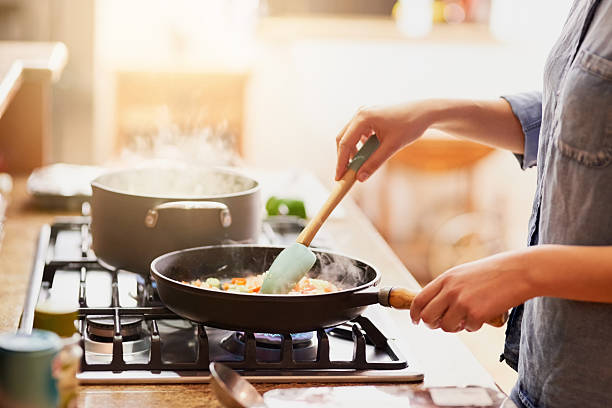
Can You Use Induction Pans On A Gas Stove
Yes, you can indeed use induction pans on gas stoves, although there are some important considerations to keep in mind. Induction pans are typically constructed with a magnetic material, such as cast iron or stainless steel, which allows them to generate heat when placed on an induction cooktop that utilizes electromagnetic fields.
While gas stoves operate on a different principle—using an open flame to heat cookware—many induction pans are compatible with gas stoves due to their magnetic properties.
However, it’s essential to ensure that the bottom of the pan is flat and in good condition to maintain proper contact with the gas burner and distribute heat evenly.
Since gas flames can extend beyond the base of the pan, it’s crucial to select a pan size that matches the burner size to prevent excessive heat exposure to the handles or nearby surfaces.
Overall, with proper attention to these factors, using induction pans on gas stoves can offer efficient and effective cooking results.
What Is Induction Cooking?
Induction cooking is a method of cooking that uses electromagnetic induction to heat cookware directly, rather than relying on heat transfer through traditional methods like gas or electric heating elements.
In an induction cooktop, a coil of copper wire is located beneath the ceramic surface, and when an alternating electric current flows through this coil, it generates a magnetic field.
When a compatible ferromagnetic (magnetic) material, such as cast iron or certain types of stainless steel, is placed on the cooktop, the magnetic field induces an electrical current within the cookware, creating resistance and generating heat.
This heat is then transferred to the food within the cookware, allowing for precise and efficient cooking. Induction cooktops are easier to clean since the surface remains relatively cool and spills are less likely to burn onto the cooktop. Overall, induction cooking is a versatile and increasingly popular method that combines speed, control, and safety for modern kitchen needs.
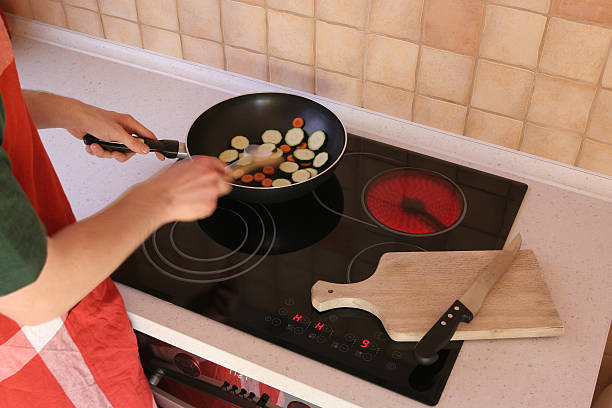
Here are some benefits of induction cooking:
Rapid heating
One of the notable advantages of induction cooking is its rapid heating capability. Unlike traditional gas or electric cooktops, which rely on indirect heat transfer to warm up cookware, induction cooktops heat pots and pans directly through electromagnetic induction.
This direct heating method allows for quick and efficient energy transfer, resulting in faster heating times compared to conventional cooking methods.
When you turn on an induction cooktop, the electromagnetic field generates heat almost instantaneously within the compatible cookware, significantly reducing the time needed to reach the desired cooking temperature.
This rapid heating feature not only saves time but also allows for more precise control over cooking processes, enabling cooks to adjust temperatures quickly and accurately to achieve optimal results.
Whether you’re boiling water, searing meats, or sautéing vegetables, the ability of induction cooktops to heat up rapidly enhances overall cooking efficiency and convenience in the kitchen.
Precise Temperature Control
Precise temperature control is another hallmark feature of induction cooking that sets it apart from traditional gas or electric cooktops. With induction technology, users have the ability to adjust cooking temperatures with exceptional accuracy and responsiveness.
Unlike gas flames or electric coils, which may take time to heat up or cool down, induction cooktops allow for instantaneous changes in temperature settings. This level of control is achieved through precise power modulation within the electromagnetic field, enabling users to select and maintain specific cooking temperatures with precision.
Many induction cooktops offer precise temperature settings that can be adjusted in increments, allowing for fine-tuning according to the requirements of different recipes.
Whether you need to simmer delicate sauces at low temperatures or sear meats at high heat, induction cooktops provide the flexibility to achieve the desired results with confidence.
Some induction cooktops feature advanced temperature control technologies, such as built-in sensors and automatic temperature adjustment functions, which help maintain consistent cooking temperatures even when external factors, such as changes in cookware or room temperature, occur.
The ability to control cooking temperatures accurately not only enhances the quality of cooked dishes but also contributes to energy efficiency by minimizing wasted heat and reducing the risk of overcooking or burning food.
Overall, precise temperature control is a key advantage of induction cooking, empowering users to cook with precision and consistency for superior culinary outcomes.
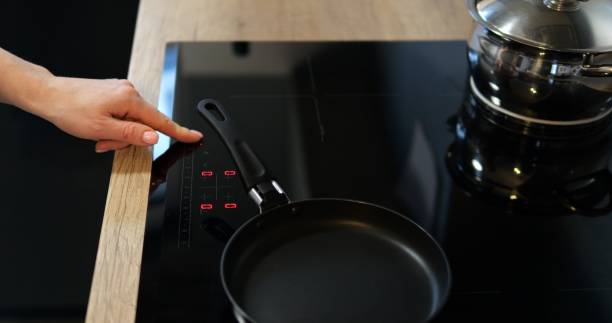
Energy Efficiency
Energy efficiency is a significant advantage of induction cooking compared to traditional gas or electric cooktops. Induction cooktops are highly efficient because they directly heat the cookware using electromagnetic induction, minimizing heat loss and energy waste.
Unlike gas stoves, which rely on burning fossil fuels to produce a flame, or electric cooktops, which use resistive heating elements that can dissipate heat into the surrounding environment, induction cooktops generate heat only within the cookware itself.
The electromagnetic field created by the induction cooktop induces an electric current in the ferromagnetic material of the cookware, rapidly heating it up.
Because the heat is generated directly in the pot or pan, there is minimal heat loss to the surrounding air or the cooktop surface. This means that less energy is required to reach and maintain cooking temperatures, resulting in shorter cooking times and lower energy consumption overall.
Furthermore, induction cooktops offer precise temperature control, allowing users to adjust heat settings quickly and accurately. This precision helps prevent overheating and reduces the likelihood of energy waste during the cooking process.
Since induction cooktops only heat up when cookware is placed on the surface, there is no residual heat generated when the cookware is removed, further reducing energy usage.
Overall, the energy efficiency of induction cooking makes it an environmentally friendly option that can help reduce energy consumption and lower utility bills while providing fast and precise cooking results.
Safety Features
Induction cooking offers several safety features that contribute to its popularity and reputation as a safe cooking method. One primary safety feature is the absence of open flames or exposed heating elements, which reduces the risk of accidental burns or fires.
Because induction cooktops heat cookware directly through electromagnetic induction, the surface of the cooktop remains relatively cool to the touch, minimizing the potential for burns from contact with the cooking surface.
Another important safety feature of induction cooktops is automatic shut-off functionality. Many modern induction cooktops are equipped with sensors that detect when cookware is removed from the surface or when it reaches excessively high temperatures.
In such cases, the cooktop automatically shuts off or reduces power output to prevent overheating or damage to the cookware. This feature helps prevent accidents and ensures peace of mind, especially in households with young children or pets.
Induction cooktops also offer safety features related to stability and control. The electromagnetic field generated by the cooktop only heats compatible ferromagnetic cookware, so there is minimal risk of accidental burns from touching the cooktop surface or nearby objects.
Induction cooktops typically include features such as pan detection and overheating protection, which further enhance safety by preventing the cooktop from operating if incompatible cookware is used or if the temperature exceeds safe limits.
Overall, the combination of features such as cool-touch surfaces, automatic shut-off, and advanced safety sensors makes induction cooking a safe and reliable choice for home kitchens, offering peace of mind and protection against common cooking-related hazards.
What Is An Induction Pan?
An induction pan, also known as an induction-compatible pan, is a type of cookware specifically designed to be used with induction cooktops. Unlike traditional pans, which may not work efficiently on induction surfaces, induction pans are constructed with materials that are magnetic and responsive to electromagnetic induction.
Typically, induction pans are made of ferromagnetic materials such as cast iron or certain types of stainless steel, which allow them to generate heat when placed on an induction cooktop.
The bottom of an induction pan is usually constructed with a magnetic material that can create a strong connection with the electromagnetic field generated by the induction cooktop. This connection enables efficient heat transfer from the cooktop to the pan, resulting in rapid and uniform heating of the cookware and its contents.
Induction pans come in various shapes and sizes, including frying pans, saucepans, stockpots, and griddles, to accommodate different cooking needs and preferences. Some induction pans feature additional features such as non-stick coatings, ergonomic handles, or multi-layered construction for enhanced durability and performance.
Overall, induction pans are essential tools for effective and efficient cooking on induction cooktops, offering compatibility, responsiveness, and versatility for a wide range of culinary tasks.
3 Types Of Induction Pans For Induction And Gas Cooktops
Certainly! Here are three types of induction pans that are suitable for use on both induction and gas cooktops:
1. Cast Iron Skillet
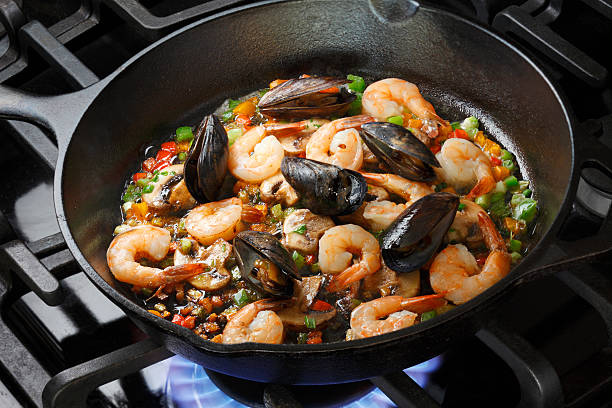
Certainly! The cast iron skillet is a timeless and versatile piece of cookware that is well-suited for use on both induction and gas cooktops. Cast iron skillets are renowned for their exceptional heat retention and even heat distribution, making them ideal for a wide range of cooking techniques, including searing, frying, baking, and even roasting.
When it comes to induction cooking, cast iron skillets are particularly advantageous due to their magnetic properties. The ferromagnetic nature of cast iron enables it to effectively interact with the electromagnetic field generated by induction cooktops, resulting in efficient heat transfer and rapid heating of the skillet.
On gas cooktops, cast iron skillets also perform admirably. The direct flame of a gas burner provides intense heat, which is well-suited for tasks such as searing meats and achieving a crispy exterior on foods. Cast iron’s ability to withstand high temperatures makes it an excellent choice for gas cooking, allowing for superior browning and caramelization.
Cast iron skillets are incredibly durable and versatile, capable of withstanding high temperatures and enduring years of use. With proper seasoning and care, they develop a natural non-stick surface that improves over time, making them easy to clean and maintain.
Whether you’re cooking on an induction or gas cooktop, a cast iron skillet is an indispensable kitchen tool that offers exceptional performance, durability, and versatility for a wide range of cooking tasks. From searing steaks to baking cornbread, the cast iron skillet delivers delicious results every time.
2. Magnetic Stainless Steel Pan

The magnetic stainless steel pan is a modern culinary marvel designed to excel on both induction and gas cooktops, offering versatility and efficiency in the kitchen.
Crafted from high-quality stainless steel infused with magnetic properties, this pan effortlessly interacts with the electromagnetic field of induction cooktops, ensuring rapid and even heating for precise cooking results.
Its durable construction and corrosion-resistant properties make it a reliable choice for everyday cooking tasks, from sautéing vegetables to simmering sauces. Moreover, on gas cooktops, the stainless steel pan showcases its exceptional heat conductivity, distributing heat evenly across the cooking surface for consistent performance.
With its sleek design, ease of maintenance, and compatibility with multiple cooking surfaces, the magnetic stainless steel pan is a must-have tool for any kitchen enthusiast seeking both functionality and style.
3. Stainless Steel Clad Pans
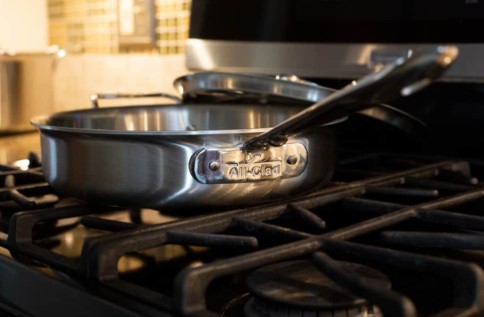
Stainless steel clad pans represent the epitome of versatility and performance, seamlessly transitioning between induction and gas cooktops with unmatched ease.
Engineered with a multi-layered construction, these pans typically feature a core of aluminum or copper sandwiched between layers of stainless steel. This design ensures optimal heat distribution and retention, allowing for precise cooking on both induction and gas surfaces.
The stainless steel exterior of the pan provides durability, corrosion resistance, and compatibility with magnetic induction cooktops, while the inner core enhances heat conductivity for efficient cooking.
Whether searing, sautéing, or simmering, stainless steel clad pans deliver consistent results across various cooking methods, making them indispensable tools in any kitchen.
Their sturdy construction, sleek appearance, and exceptional performance make them a favorite among professional chefs and home cooks alike, offering reliability and versatility for a wide range of culinary endeavors.
Thing To Keep In Mind When Buying An Induction Pan
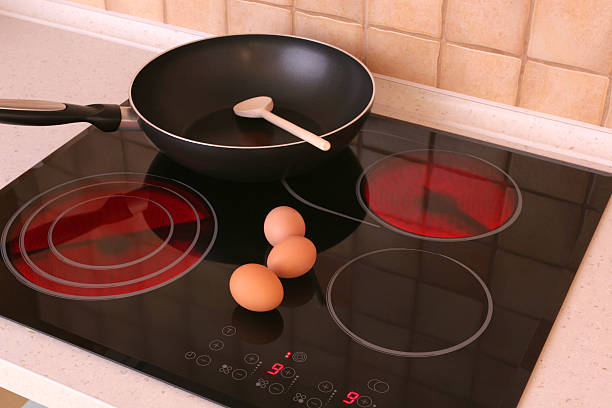
When purchasing an induction pan, there are several important factors to consider to ensure that you choose the right one for your cooking needs:
Compatibility
When purchasing an induction pan, the foremost consideration is compatibility with your induction cooktop. Since induction cooking relies on electromagnetic induction to generate heat, it’s essential to choose pans made from ferromagnetic materials that can effectively interact with the magnetic field produced by the cooktop.
Look for pans specifically labeled as “induction-compatible” or “induction-ready.” Common materials that work well with induction cooktops include cast iron and magnetic stainless steel.
Avoid pans made from materials such as aluminum, copper, or glass, as they are not magnetic and will not heat up on an induction cooktop. Ensuring compatibility between your induction pan and cooktop is crucial for achieving optimal cooking performance and efficiency.
Flat Bottom
Another important consideration when buying an induction pan is to ensure it has a flat bottom. Induction cooktops require direct contact between the bottom of the pan and the cooking surface to generate heat efficiently.
A flat bottom ensures maximum surface area contact with the induction cooktop, promoting even heat distribution and minimizing hot spots. Pans with warped or uneven bottoms may not make proper contact with the cooktop, leading to inefficient heating and uneven cooking.
When selecting an induction pan, inspect the bottom surface to ensure it is flat and smooth. Some pans feature a disc of magnetic material bonded to the bottom to improve compatibility and contact with the induction cooktop. Choosing a pan with a flat bottom ensures optimal performance and cooking results on your induction cooktop.
Size and Shape
Consideration of size and shape is crucial when purchasing an induction pan. Firstly, ensure that the size of the pan is suitable for your cooking needs and the dimensions of your induction cooktop.
Pans that are too large may not fit comfortably on the cooktop surface, while those that are too small may not provide adequate cooking capacity for your recipes. Consider the shape of the pan based on the types of dishes you frequently prepare.
For example, if you often cook sauces or soups, a saucepan with tall sides may be preferable, while a skillet with sloped sides may be better suited for sautéing or frying. It’s also essential to consider the depth of the pan, as deeper pans are suitable for dishes with more liquid, while shallow pans are ideal for tasks like searing or browning.
Ultimately, choosing the right size and shape of the induction pan ensures efficient cooking and optimal utilization of your cooktop’s heating capabilities.
Weight
Another important factor to consider when buying an induction pan is its weight. While it’s essential to choose a pan that feels sturdy and well-made, it’s also crucial to ensure that it’s not too heavy for your comfort and the capabilities of your induction cooktop.
Induction cooktops have weight limits, and using pans that exceed these limits can potentially affect the performance of the cooktop or even cause damage over time. Heavy pans can be cumbersome to handle, especially when filled with food.
Consider your own strength and comfort level when selecting a pan weight that feels manageable for you. Opting for a pan that strikes the right balance between durability and weight ensures both efficient cooking and ease of use on your induction cooktop.
Quality Construction
When purchasing an induction pan, it’s essential to prioritize quality construction. A well-made pan not only ensures optimal cooking performance but also enhances durability and longevity.
Look for pans that are constructed from high-quality materials and feature solid craftsmanship. Stainless steel pans with multiple layers (such as tri-ply or multi-ply construction) are excellent choices as they offer superior heat distribution and durability.
Pans with sturdy handles securely attached to the body of the pan with rivets or welding provide stability and ease of handling. Check for smooth edges, tight-fitting lids, and overall attention to detail in the construction of the pan.
Investing in a high-quality induction pan may require a slightly higher upfront cost, but it pays off in the long run with reliable performance and lasting durability, making it a worthwhile investment for your kitchen.
Heat Resistance
Heat resistance is a crucial factor to consider when buying an induction pan, especially if you plan to use it for high-temperature cooking methods or if you intend to transfer it from the cooktop to the oven.
Choose a pan that can withstand high temperatures without warping, discoloration, or compromising its performance. Look for pans made from materials known for their heat resistance, such as stainless steel or cast iron.
Consider whether the pan is oven-safe and up to what temperature it can safely withstand. Many induction pans are designed to be oven-safe, but it’s essential to check the manufacturer’s specifications to ensure compatibility with your cooking preferences.
A pan with excellent heat resistance provides versatility and peace of mind, allowing you to use it for a wide range of cooking techniques without worrying about damage or deterioration.
Non-Stick Coating
When selecting an induction pan, it’s worth considering whether you prefer a non-stick coating. Non-stick coatings can make cooking and cleaning easier by preventing food from sticking to the pan’s surface.
If you opt for a non-stick pan, ensure that it is made with a high-quality, durable non-stick coating that is free from harmful chemicals like PFOA and PTFE. Look for coatings that are scratch-resistant and can withstand high temperatures without deteriorating or releasing toxic fumes.
Consider the type of utensils you’ll be using with the pan, as metal utensils can damage some non-stick coatings. Ultimately, choosing a non-stick coating is a matter of personal preference and cooking style, but selecting a high-quality coating ensures both safety and longevity for your induction pan.
Price and Warranty
Price and warranty are important factors to consider when buying an induction pan. While it’s tempting to opt for the cheapest option available, investing in a higher-quality pan often pays off in the long run. Higher-priced pans typically offer better construction, performance, and durability, which can result in better cooking experiences and longevity.
However, it’s also essential to balance quality with your budget. Set a reasonable price range based on your needs and preferences, and consider factors such as material, construction, brand reputation, and additional features when comparing options.
Check the warranty offered by the manufacturer. A longer warranty period indicates that the manufacturer stands behind the quality and durability of their product. Be sure to review the warranty terms and conditions, including any limitations or exclusions, to understand what is covered and for how long.
Ultimately, choosing an induction pan with a balance of quality, price, and warranty ensures that you get the best value for your investment and enjoy reliable performance for years to come.
Frequently Asked Questions (FAQs) – Can You Use Induction Pans On A Gas Stove
Are Induction Pans Versatile Enough for Gas Stoves?
Indeed! Induction pans are designed to be adaptable across various cooking surfaces, including gas stoves. Their versatility ensures you can enjoy your favorite recipes regardless of your stove type.
Do Induction Pans Enhance Efficiency on Gas Stoves?
Absolutely! Induction pans are known for their exceptional heat conductivity, which translates to quicker and more efficient cooking on gas stoves. You’ll experience faster cooking times and precise temperature control.
Will Using Induction Pans on Gas Stoves Save Energy?
Yes! Induction pans’ excellent heat retention properties mean less energy is required to maintain desired temperatures on gas stoves. This eco-friendly approach not only saves energy but also reduces your utility bills.
Can I Achieve Consistent Cooking Results with Induction Pans on Gas Stoves?
Certainly! The even heat distribution of induction pans ensures consistent cooking results, whether you’re simmering, sautéing, or searing on your gas stove. Say goodbye to hot spots and unevenly cooked meals!
Are Induction Pans Compatible with All Gas Stove Designs?
Absolutely! Induction pans are crafted to work seamlessly with a wide range of gas stove models. Their compatibility ensures you can enjoy hassle-free cooking experiences without worrying about equipment compatibility.
Do Induction Pans Enhance Safety on Gas Stoves?
Yes! Induction pans’ sturdy construction and ergonomic designs contribute to safer cooking practices on gas stoves. Features like heat-resistant handles and non-slip bases offer peace of mind during meal preparation.
Will Using Induction Pans on Gas Stoves Simplify Cleanup?
Definitely! Induction pans’ non-stick surfaces and easy-to-clean designs make post-cooking cleanup a breeze on gas stoves. Spend less time scrubbing and more time enjoying your culinary creations!
Can I Use Induction Pans to Elevate My Cooking Experience on Gas Stoves?
Absolutely! Induction pans’ premium quality and innovative designs can elevate your cooking experience on gas stoves. Whether you’re a culinary enthusiast or a seasoned chef, you’ll appreciate the enhanced performance and versatility they offer.
Are Induction Pans a Sustainable Choice for Gas Stove Cooking?
Yes! Induction pans’ durability and energy-efficient properties make them a sustainable choice for cooking on gas stoves. By investing in quality cookware, you’re contributing to a greener future while enjoying delicious meals.
Do Induction Pans Offer Long-term Value for Gas Stove Users?
Absolutely! Induction pans’ durability, efficiency, and versatility ensure they provide long-term value for gas stove users. With proper care, these high-quality pans can withstand years of use, making them a worthwhile investment for any kitchen.
Conclusion
In conclusion, the compatibility of induction pans with gas stoves presents a nuanced consideration for consumers seeking efficient and versatile cookware options.
While traditional gas stoves may not directly induce heat in these pans, advancements in technology have led to the development of hybrid induction-compatible pans suitable for both induction and gas cooking methods.
However, caution and research are advised to ensure optimal performance and safety when using induction pans on gas stoves, considering factors such as material composition, manufacturer guidelines, and potential heat distribution discrepancies.
Ultimately, the choice between induction pans and conventional cookware for gas stoves depends on individual preferences, cooking habits, and the desire for innovation in culinary experiences.
Related Posts: